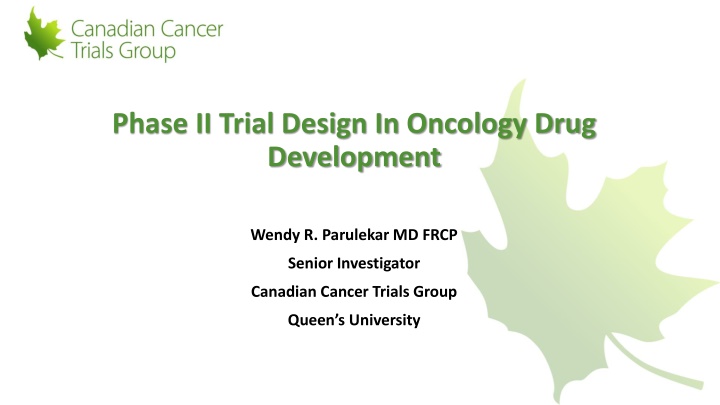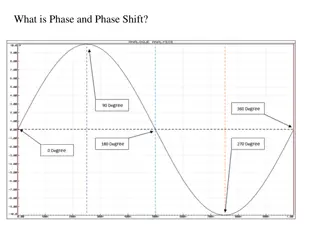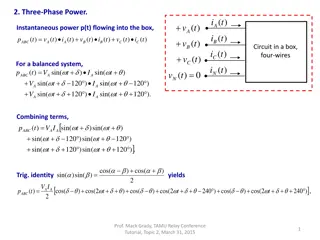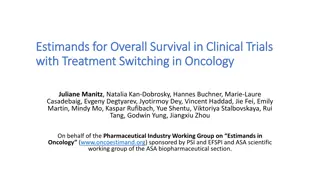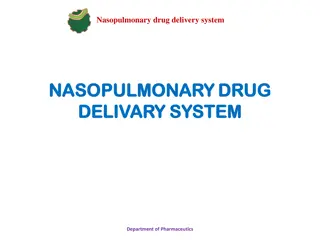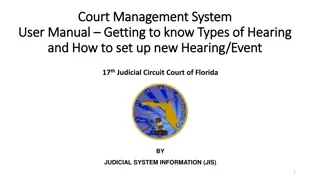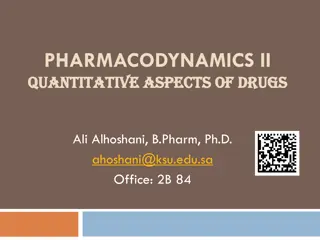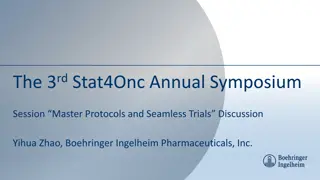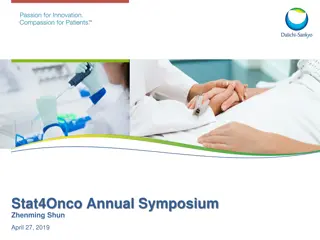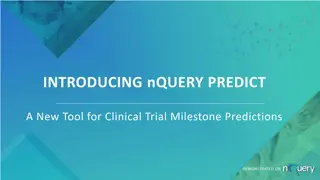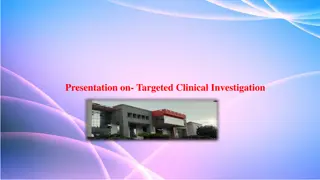Phase II Trial Design in Oncology Drug Development by Wendy R. Parulekar, MD, FRCP
This presentation covers the pivotal role of Phase II trials in oncology drug development, emphasizing the importance of preliminary clinical efficacy screening, adverse event profiling, mechanism of action understanding, and target population definition. It discusses various Phase II trial designs, endpoints, statistical considerations, and sampling methods, highlighting the critical decision-making based on Phase II trial results.
Download Presentation

Please find below an Image/Link to download the presentation.
The content on the website is provided AS IS for your information and personal use only. It may not be sold, licensed, or shared on other websites without obtaining consent from the author.If you encounter any issues during the download, it is possible that the publisher has removed the file from their server.
You are allowed to download the files provided on this website for personal or commercial use, subject to the condition that they are used lawfully. All files are the property of their respective owners.
The content on the website is provided AS IS for your information and personal use only. It may not be sold, licensed, or shared on other websites without obtaining consent from the author.
E N D
Presentation Transcript
Phase II Trial Design In Oncology Drug Development Wendy R. Parulekar MD FRCP Senior Investigator Canadian Cancer Trials Group Queen s University
Disclosures Pfizer Celgene Hecht Foundation CBCF CIHR AstraZeneca TerSera Roche Novartis/AAA 2
Learning Objectives To define the role of a phase II trial in oncology drug development To describe the objectives and the statistical parameters that provide the framework of a phase II trial design
Phase II Trial The phase II trial has a pivotal role in drug development since the major decision to proceed with further testing is usually based on phase II trial results.
Phase II Trial Screens for Efficacy Primary goal Identify and characterize the preliminary clinical efficacy of a new agent/ combination of agents/ schedule of administration Secondary goals Characterize adverse event profile Understand mechanism of action Further define target population for administration of agent
Phase II Trial Designs Multiple designs available Variations based on specific stage of development of the therapeutic intervention how the results will inform continued therapeutic development
Phase II Trial Designs Defining characteristics Endpoints: primary and secondary Single or two stage design Single arm or multiple arm design Statistical considerations: Type I ( ) and II ( ) error rates; measures of anticancer activity (e.g. response rates, hazard ratio .)
Standard Single Arm Phase II Trial Comparison is fixed constant historical control Binary endpoint (e.g. clinical response vs. no response) Requirements = Type I error = Type II error H0: null response rate not of interest HA: target response rate of interest Based on design parameters sample size= N
A Phase II Single Arm Trial of Elective Volume Adjusted De-Escalation Radiotherapy (EVADER) in Patients with Low-risk HPV-related Oropharyngeal Squamous Cell Carcinoma HN.10
Rationale Low risk, HPV associated oropharyngeal squamous cell carcinoma Curatively treated with radiotherapy Long term treatment related morbidity is common eg. swallowing and salivary gland function Volume de escalation of radiotherapy fields may lessen burden of toxicity without a compromise in disease control
HN.10 Endpoints Primary Two year event free survival Secondary Overall survival Disease control (local, regional, local-regional, out-of-field regional) Distant metastasis free survival Early and late toxicities of treatment Subjective swallowing functions Quality of life (QOL) Utilization of healthcare resources, work productivity Prognostic biomarkers
HN.10 Statistical Parameters 2 year EFS: H0 < 85% HA =91% Type 1 ( ) error = 0.10; power (1- ) = 80% Sample size 100; 304.7 person-years of follow-up required for the final analysis Current Status: accrual complete, follow-up ongoing
Can we improve the efficiency of the single stage phase II trial design? 15
Two stage trial designs will limit exposure to inactive treatment strategies 16
Two-Stage Trial Designs Gehan two-stage design (1961) Allows early termination for inefficacy Fleming two-stage design (1982) Allows early termination due to efficacy or inefficacy Simon two stage design (1989) Preserves the type I ( ) and II ( ) error rates and allows an early look; minimizes the expected sample size for an inactive treatment strategy
Sunitinib in relapsed or refractory diffuse large B-cell lymphoma: a clinical and pharmacodynamic phase II multicenter study of the NCIC Clinical Trials Group IND.182 BUCKSTEIN ET AL., LEUK LYMPHOMA 2011
Rationale Relapsed or refractory diffuse large B cell lymphoma 25-30% cured with salvage chemotherapy and bone marrow transplant VEGF pathway is important implicated in progression Sunitinib is an orally bioavailable inhibitor affecting receptor tyrosine kinases involved in tumor proliferation and angiogenesis (VEGFR-1, -2, -3, and PDGFR-a and b)
IND.182 R E G I S T E R Relapsed/ refractory or transformed B cell lymphoma Sunitinib 37.5 mg po daily, q 4 weeks Response
IND.182 Endpoints Primary Objective response using standard criteria for non-Hodgkin lymphoma Secondary Toxicity Progression Free Survival (PFS) Anti-angiogenic activity: circulating and apoptotic endothelial cells and precursors
IND.182 Statistical Parameters H0 =5% HA =20% Type 1 ( ) error = 0.12 ; power (1- ) = 89% Two stage: Ist stage: enroll 15 patients continue if at least one response 2nd stage: additional 10 patients Sunitinib worthy of further study if at least 3 responses in 25 patients
IND.182 Results Response Rate First stage: 17 eligible patients, 15 evaluable for response No responses seen study stopped No convincing pharmacodynamic evidence of antiangiogenic activity (CEC and CEP biomarker analysis)
IND.182 Conclusions Sunitinib Inactive in patients with relapsed or refractory diffuse large B cell lymphomas
Single Arm Phase II Trial Design Limitations Challenging due to choice of historic control for estimation of H0 Biases in patient selection, earlier detection of disease states, differences in disease outcome assessment, improvements in supportive care may contribute to estimate of activity - independent of drug effect 25
Can we refine the design of the phase II trial? 26
Randomized phase II trial designs may address some of the limitations of the single arm trial: confounding, reliance on historic estimates of efficacy for H0, resource allocation constraints.. 27
Randomized Phase II Trial Design Randomization is a process and further details are needed to understand the goals and design of the trial
Randomized Phase II Trial Design: Experimental Arm with Concurrent Control to Anchor Interpretation 29
Docetaxel and Prednisone With or Without OGX-011 in Patients With Metastatic Castration- Resistant Prostate Cancer IND.165 CHI ET AL, J CLIN ONCOL 2010
Rationale Castration Resistant Prostate Cancer (CRPC) Characterized by disease progression despite castrate state Highly lethal despite chemotherapy sensitivity to docetaxel regimens Clusterin is a cell survival protein which is induced by therapeutic stressors and is expressed in CRPC
OGX-011 in CRPC OGX-011 Second generation antisense molecule that is complimentary to clusterin mRNA translation initiation site Biologically effective dose 640 mg tested prior to prostatectomy Well tolerated > 90% inhibition of clusterin Increased apoptosis Phase I study demonstrated safety with docetaxel
IND.165 R A N D O M I Z E Docetaxel 75 mg IV q 3 weekly Prednisone 5 mg po bid Metastatic prostate cancer with progression on androgen ablation Efficacy Docetaxel 75 mg IV q 3 weekly Prednisone 5 mg po bid OGX-011 640 mg IV loading dose then weekly N= 40 per arm
IND.165 Endpoints Primary Proportion of patients with PSA decline > 50% from baseline Secondary Response Rate (RR) Toxicity Progression Free Survival (PFS) Overall Survival (OS) Changes in serum clusterin
IND.165 Statistical Parameters Docetaxel + Prednisone + Clusterin arm H0 < 40% HA >60%, Type 1 error = 10% (1 sided); power = 90% 20 or more PSA responses in 40 enrolled patients
IND.165 PSA Response Docetaxel + Prednisone + OGX 011: 58% (90% CI 43.3-70.8) Docetaxel + Prednisone: 54% (90% CI 39.8-67.1)
IND.165 Endpoints Secondary Endpoint Docetaxel + Prednisone + OGX 011 Docetaxel + Prednisone 19% (95% CI 6.6-39.4) 25% (95% CI 9.8-46.7) RR (95% CI) 7.3 months (95% CI 5.3-8.8) 6.1 months (95% CI 3.7-8.7) Median PFS (95% CI) Median 23.8 months (95% CI 16.2-not reached) 16.9 months (95% CI 12.8-25.8) Overall Survival (95% CI)
IND.165 Conclusions Docetaxel/ prednisone plus OGX 011: Well tolerated Predefined protocol criteria for further study met but similar rates of PSA decline and RR in both arms Evidence of biological effect with decreases in serum clusterin Trends in PFS and OS are of clinical interest Exploratory analyses of OS strongly suggest clinical benefit (HR 0.50 95%CI 0.29-0.87)
IND.165 Randomized Phase II Trial Concurrent control included to anchor interpretation of experimental arm Experimental arm: H0, HA, error rates predetermined as in a single arm phase II Subsequent phase III trials failed to demonstrate efficacy
Randomized Phase II Trial Design: Multiple Experimental Arms (Selection Design) 41
Selection Design Simultaneous evaluation of multiple experimental regimens Prioritization for further evaluation based on antitumour activity, safety, tolerability, compliance 42
EVEROLIMUS in Breast Cancer IND.163 ELLARD ET AL J CLIN ONCOL 2009
Rationale Breast Cancer Common, incurable in the advanced disease setting mTOR (mammalian target of rapamycin) Involved in cell replication Mediates the critical PI3K/AKT pathway which is active in breast cancer Other functions: mediates VEGF, PDGF and TGF Preclinical inhibitor of mTOR inhibits proliferation Other mTOR inhibitors active against solid tumours (temsirolimus renal cell carcinoma)
Everolimus in Breast Cancer Everolimus Orally bioavailable Uncertainty about optimal dosing schedule: weekly versus daily
IND.163 R A N D O M I Z E Recurrent/ metastatic breast cancer Everolimus 10 mg po daily for 28 days q4 weeks RR and early progression* Strat factors: Visceral metastases Prior chemo regimens Everolimus 70 mg po once weekly (day 1, 8, 15, 22) q4 weeks N < 30 each arm * Zee B, et al. J Biopharm Stat 1999
IND.163 Objectives Primary To evaluate in parallel fashion in each arm: Anti tumour efficacy based on RR and early PD Secondary To evaluate in parallel fashion in each arm: Adverse event, time to progression and response duration To correlate RR with molecular markers of mTOR activity To correlate RR with molecular markers of mTOR activity in fresh tumour samples (consenting patients)
IND.163 Statistical Parameters No formal comparison between the two arms H0 response = 0.05 H0 early progression = 0.60 HA response =0.20 HA early progression = 0.40 First stage, enter 15 patients each arm If 0 responses AND 10 or more early progressions, stop entry into that arm. If 1 or more responses OR < 10 early progressions, continue that arm and enter 15 more patients.
IND.163 Statistical Parameters After 30 patients total per arm If 4 or more responses OR if 13 or fewer early progressions, accept drug as worth further study Corresponds to type 1 error = 10% power = 93%
IND.163 Results Daily Schedule: 4 responses (12%; 95% CI, 3.4% to 28.2%) Weekly Schedule: 0 responses; 11 early progressions end of stage 1
